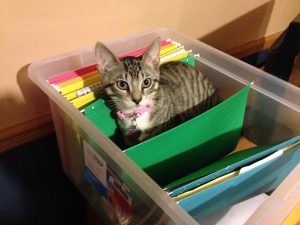 You thought you had trouble keeping your home organized; now you have to shrink your available space down to a mere 100th of that? With the airlines’ restrictions and charges on baggage, making efficient use of a 28”x 21”x 12” space (or smaller) will really exercise your organizing muscles! There are things you can do to make packing – whether for family vacation or summer camp – work better for you than it has in the past. Here’s how you can make the most of the little space you have (with partial thanks to AAA).
You thought you had trouble keeping your home organized; now you have to shrink your available space down to a mere 100th of that? With the airlines’ restrictions and charges on baggage, making efficient use of a 28”x 21”x 12” space (or smaller) will really exercise your organizing muscles! There are things you can do to make packing – whether for family vacation or summer camp – work better for you than it has in the past. Here’s how you can make the most of the little space you have (with partial thanks to AAA).
And once you’re up, up and away…
Click here to learn more about the author, Ellia Ryan.
 As a Productivity and Organizing Professional, I am preoccupied with effective ways to calm the chaos in people’s lives. When I saw this short 3 minute video, I thought it was a great demonstration of how disorganization and chaos unfold without notice while everything falls into disarray and nothing gets done. If you can relate, then here are 8 easy suggestions to help calm the chaos in your life.
As a Productivity and Organizing Professional, I am preoccupied with effective ways to calm the chaos in people’s lives. When I saw this short 3 minute video, I thought it was a great demonstration of how disorganization and chaos unfold without notice while everything falls into disarray and nothing gets done. If you can relate, then here are 8 easy suggestions to help calm the chaos in your life.
In the video, the chaos began when the actor put her keys down on the table to pick up the mail. In that moment, she lost her connection to her keys and shifted her attention to the mail. She no longer had a cognitive or tactile association with the keys. Her connection transferred to the mail instead. That loss of connection was played out over and over in the video as the chaos unfolded. She lost her awareness of her checkbook, the remote, her glasses and, ultimately, her ability to complete a task with ease.
If you must pick up the mail before putting your keys in their designated spot (create one if you don’t already have one), hold onto the keys. That is, stay connected to the keys while you are sorting the mail. Then, when your attention turns away from the mail, your keys will be in your hand as a tactile reminder that the task of putting your keys away is not complete.
If the actor had held onto her keys while she sorted the mail, or her checkbook while she walked to her desk and then to the kitchen with her warm Coke, both her keys and checkbook would have signaled to her that the task wasn’t done, and ultimately reduced the number of incomplete tasks left in her wake.
The video shows how random the actor moved from one task to another. What caught her attention became the next priority without thought or question. If this feels familiar, try counting to 8 slowly before you move from one task to another. This allows time to slow down and contemplate which task is more important and should be done first.
If the actor took time to stop and count to 8 before shifting from one task to another, she could have made conscious choices to either stop what she was doing and move to another task or not. Having time to choose lends itself to better outcomes and less chaos.
Taking on and practicing one or more of these suggestions, over time, will strengthen your ability to calm the chaos and be more effective, efficient and productive.
In oftentimes challenging situations loaded with minefields and judgments, have fun trying different ways to “stay connected” to a task. So I can’t forget things while I’m working, I wear a “task pouch” around my waist with pockets like a carpenter’s tool belt. In it is everything I need at my fingertips: phone, markers, scissors, and a pad and a pen to capture tasks to do and things to remember. This is my way of keeping worry and brain chaos at bay.
Be compassionate with yourself when taking on new practices. Misses and backsliding are common during any learning process.
If you find you need support, new ideas, a coach or a cheerleader as you take on new practices, give one of us a call. We would love to assist you in calming the chaos in your life!
 Whether your office is in your home or away from home, now is the perfect time to start getting organized for 2018. The holidays have not officially started, even though you wouldn’t know it by the decorations in some stores already. In addition, tax time will be here before you know it.
Whether your office is in your home or away from home, now is the perfect time to start getting organized for 2018. The holidays have not officially started, even though you wouldn’t know it by the decorations in some stores already. In addition, tax time will be here before you know it.
Think how you would feel if you did not use your floor for a filing cabinet. C’mon now, I know you do!
Here are 5 tips to help you get your office in order:
Productivity and efficiency will greatly improve if your office space is organized. You won’t spend an inordinate amount of time looking for things, you won’t spend additional money on items you already have, and you’ll be able to use the freed-up time doing those things that are important to you.
P.S. Now, de-clutter and organize your floor. You have just created extra space in your file cabinets and drawers in which to put those items.
Life in the 21st century is anything but simple. Our world feeds us countless messages defining what we need in order to be happy, successful, and fulfilled. We’ve all heard these messages, either directly or indirectly, and we’ve all bought into at least some of the hopeful promises that our lives can improve…if only we [you fill in the blank].
But the true result of our modern life, trying to keep up with our packed schedules, overflowing to-do lists, and material abundance is sadly, not satisfaction and peace. Rather, we have stress, anxiety, broken relationships, and a LOT of stuff.
So, in the complexity of our technological age, what does it mean to simplify? What does a simpler life look like for an ordinary family keeping up with work, school, and countless demands? Regardless of the season of life—a young couple, family with children, or empty nesters—how can any of us find a greater level of simplicity in our noisy, chaotic, energetic world?
The beautiful truth is that the concept of “living simply” looks different for each person and every family. What I deem a simpler, less complicated life for my family will undoubtedly look different from your ideal. The challenge is that it takes effort to figure out how to step out of a cluttered and demanding lifestyle to pursue a more balanced and satisfying experience of daily life.
I want to highlight the two qualities that define a simpler life, according to Deborah DeFord in her book, The Simpler Life (The Readers Digest Association, Inc, 1998). These are integrity and intentionality.
Integrity is defined as a state of being whole and undivided. This ideal means I need to look at what is important to me, and then live according to those goals and values. If I believe physical fitness is important but never make time in my week to get up and move, then I am not living an integrated life. Rather, to live according to what I value, I will commit to walking 3 times each week and schedule it on my calendar. It’s as simple as that: Live in accordance with what is important to you.
Intentionality means we act with purpose. We consciously decide the choices we make throughout our day. Thus, to be intentional requires a certain mindfulness. If we are always “going with the flow,” we may feel spontaneous, but we are not in control of our day. We are reacting rather than being proactive. I must admit that I sometimes fell prey to impulse purchases, buying things because they were on sale, even though they were not items on my list. The result was I spent money I hadn’t planned to spend, brought home things I might not actually use, and then had to find a place to store my latest bargains. Learning to live with intention means pausing to evaluate my true needs.
How will pursuing integrity and intentionality help you lead a simpler life?
Only you can decide what is most important to you. Only you can be in control of the way you spend your time, the things you buy, and the relationships you pursue. When you proactively make decisions on what you need in your life and shut out the noise of what others are proclaiming, you will have the ability to pursue only those people, activities and things that give meaning to your life. Saying “no” to the unnecessary is saying “yes” to what is most valuable—which leads to true satisfaction, contentment, and peace.
September is well under way which means the kids are back to school and its time to get ready for fall. Part of being a NAPO Organizer is helping our clients be prepared for the crazy predicaments life throws our way. I have compiled this comprehensive list to give you a jump start on fall home maintenance so that you and your family have more time for apple picking and pumpkin carving!
1. Wash exterior windows.
2. Clean gutters and down spouts.
- HACK: Try using a plastic spatula; it fits perfectly, won’t scratch gutters and is easy to clean.
- While your up there look for loose shingles and debris. HACK: binoculars help magnify loose shingles.
3. Sweep off front porch and put away summer décor: Don’t forget cushions, outdoor furniture, kid’s sprinklers and kiddie pools.
4. Create or reorganize space in the garage for summer tools & toys.
5. Put out new fall mat and add fall décor.
6. Clean, cover and store grill.
7. Water your lawn. You may think it’s time to put the sprinklers away but watering your lawn in the fall is actually a great way to help it recover from the stress of the summer sun and strengthen it for winter.
- If you fertilize your lawn in the fall it will need the H2O to help it soak up the nutrients.
- In a few weeks you can drain garden hoses and shut off water supply to spigots.
- Additionally, fall is the perfect time to aerate soil.
- It relieves compaction and allows air, water and nutrients to penetrate your lawn.
8. Order firewood or get choppin!
9. Get your chimney cleaned and inspected.
10. Winterize air conditioning unit or remove and store window units. Bring out the space heaters.
- To properly store your window units you will need to clean it first. After its been cleaned, remove the filter and with a soft brush clean it with warm, soapy water then rinse and allow it to air dry. Do a visual inspection of the filter and if the cleaning didn’t do the trick, then you should replace it. Once it’s dry, place the clean filter back in the air conditioner. Place the unit in its original box or a plastic storage tote.
- Store in a warm, dry place.
11. Check weather stripping on doors and caulk around windows.
- In a few more weeks it will be time to winterize.
- Check with your township or local community center to see if they are distributing free winterizing/energy-saving kits.
12. Dust fans, light fixtures and reverse direction of ceiling fans. Running fans in the cooler months can actually save on heating costs! Fans have slightly angled blades that when turning counterclockwise move air down. Warm air naturally rises so by switching the rotation of your ceiling fan it pushes the warm air down. Most fans have a small switch to reverse the direction.
Clockwise = Winter Counterclockwise = Summer
13. Vacuum couch cushions, collect change and lost snacks and display some cozy throws blankets.
14. Give your oven a thorough clean inside & out as well as BEHIND it to get it ready for the holiday cooking season.
15. Pack summer clothes and bedding; wash and store.
- Consider keeping swimsuits and towels handy in case you plan a winter vacation.
- Pull winter clothes, flannels and heated blankets from storage and air them out.
16. Check car for shovel, ice scraper, blanket and refill or create an emergency kit
- Read my NAPO blog “An Organized Car for 2017” for tips on what you need in your car https://www.napo-gpc.org/2017/01/an-organized-car-for-2017
I had a life-changing epiphany. It was on May 27, 1978 in the wee hours following opening day of Atlantic City’s first casino, Resorts. My then-boyfriend and I were there until the casino closed (pre-24-hour operation). We drove around Atlantic City, off the main roads. I was stunned to see truly deplorable living conditions. I felt guilty about all I had and didn’t fully appreciate.
My epiphany? I would never again complain about things I didn’t have – I had everything I needed and much of what I wanted.
I’ve kept that promise. In fact, a few years ago I stopped buying stuff I didn’t need and avoided shopping centers. Maybe it was due to organizing and downsizing other people’s stuff, sometimes massive amounts. Or because I didn’t want more stuff. Probably both, plus Pareto’s 80/20 Rule: We use 20% of our things 80% of the time.
I don’t mean to sound like a scrooge. If you’re OK with your amount of stuff, have enough space, can afford and enjoy buying new things, and your life is not negatively impacted, that’s great!
But if you feel as I do, walk around your house, take a mental inventory and ponder these questions before buying more things.
Now when I shop for something new (who doesn’t like new things sometimes?), I focus on my goal and try to avoid aimless browsing – you know, how guys shop. I discovered it’s liberating being free from societal and marketing pressures to buy more, or the latest whatever, to be happy. You too can buck the gotta-have-more, gotta-have-it-now mentality with a change in perspective. You can do it yourself or with help from an organizing consultant.
I am truly happy with the many beautiful things I own. I have more than some and less than others. But I have more than enough. I’ll never own an Aston Martin and I’m OK with that!